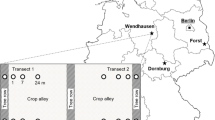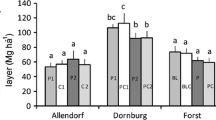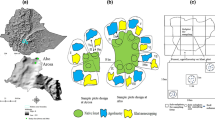Abstract
Short-rotation coppices (SRC) and alley cropping agroforestry systems (ACS) provide ecosystem services and environmental benefits. Particularly, their role in improving soil quality has frequently been emphasised. However, the economic lifetime of fast growing tree plantations may be limited, making a transition indispensable. Since information on effects of such land-use changes on soil microbial properties is scarce, the aim of this study was to assess effects of converting a German poplar-based SRC to a silvo-arable ACS, comprising rootstock incorporation and reduced tillage, on soil quality indicators after one year. Soils were sampled under poplars and within the re-converted alleyway. Distance transects were considered to further include potential beneficial effects of remaining trees on alleyway topsoil quality. We analysed soil organic carbon (SOC), total nitrogen, soil microbial biomass C and N, ergosterol, microbial activity (enzyme activities, multi-substrate-induced respiration rates), ratios relative to SOC, fungal abundance and microbial functional diversity at two topsoil depths (0–5, 5–20 cm). Repeated measures mixed effects models were calculated for each depth, considering spatial dependence structures and potential heterogeneity of abiotic factors (pH, clay contents). SRC to ACS conversion decreased SOC, microbial biomass and activity in upper topsoils within the arable alleyway, irrespective of tree distance. Furthermore, shifts in the composition of main microbial groups towards a lower fungal abundance and functional diversity were observed. Reductions of fungal indices were also identified in lower topsoils. Unexpectedly, results demonstrated that partial conversion of a SRC back to arable cropping decreased soil quality within as little as one year.


Similar content being viewed by others
References
Anderson TH, Domsch KH (1990) Application of eco-physiological quotients qCO2 and qD on microbial biomasses from soils of different cropping histories. Soil Biol Biochem 22:251–255
Baldrian P, Valášková V (2008) Degradation of cellulose by basidiomycetous fungi. FEMS Microbiol Rev 32:501–521
Bardgett RD, Bowman WD, Kaufmann R, Schmidt SK (2005) A temporal approach to linking aboveground and belowground ecology. Trends Ecol Evol 20:634–641
Beuschel R, Piepho HP, Joergensen RG, Wachendorf C (2019) Similar spatial patterns of soil quality indicators in three poplar-based silvo-arable alley cropping systems in Germany. Biol Fertil Soils 55:1–14
Brookes PC, Landman A, Pruden G, Jenkinson DS (1985) Chloroform fumigation and the release of soil nitrogen: a rapid direct extraction method for measuring microbial biomass nitrogen in soil. Soil Biol Biochem 17:837–842
Caldwell BA (2005) Enzyme activities as a component of soil biodiversity: a review. Pedobiologia 49:637–644
Campbell CD, Chapman SJ, Cameron CM, Davidson MS, Potts JM (2003) A rapid microtiter plate method to measure carbon dioxide evolved from carbon substrate amendments so as to determine the physiological profiles of soil microbial communities by using whole soil. Appl Environ Microbiol 69:3593–3599
Cardinael R, Guinet B, Chevallier T, Dupraz C, Cozzi T, Chenu C (2018) High organic inputs explain shallow and deep SOC storage in a long-term agroforestry system—combining experimental and modelling approaches. Biogeosciences 15:297–317
Degens BP, Schipper LA, Sparling GP, Vojvodic-Vukovic M (2000) Decreases in organic C reserves in soils can reduce the catabolic diversity of soil microbial communities. Soil Biol Biochem 32:189–196
Djajakirana G, Joergensen RG, Meyer B (1996) Ergosterol and microbial biomass relationship in soil. Biol Fertil Soils 22:299–304
Don A, Schumacher J, Freibauer A (2011) Impact of tropical land-use change on soil organic carbon stocks—a meta-analysis. Glob Change Biol 17:1658–1670
Don A, Osborne B, Hastings A, Skiba U, Carter MS, Drewer J, Flessa H, Freibauer A, Hyvönen N, Jones MB, Lanigan GJ, Mander Ü, Monti A, Djomo SN, Valentine J, Walter K, Zegada-Lizarazu W, Zenone T (2012) Land-use change to bioenergy production in Europe: implications for the greenhouse gas balance and soil carbon. Glob Change Biol Bioenergy 4:372–391
Ekenler M, Tabatabai MA (2003) Tillage and residue management effects on β-glucosaminidase activity in soils. Soil Biol Biochem 35:871–874
Frey SD, Elliott ET, Paustian K (1999) Bacterial and fungal abundance and biomass in conventional and no-tillage agroecosystems along two climate gradients. Soil Biol Biochem 31:573–585
Georgiadis P, Vesterdal L, Stupak I, Raulund-Rasmussen K (2017) Accumulation of soil organic carbon after cropland conversion to short-rotation willow and poplar. Glob Change Biol Bioenergy 9:1390–1401
Guggenberger G, Frey SD, Six J, Paustian K, Elliott ET (1999) Bacterial and fungal cell-wall residues in conventional and no-tillage agroecosystems. Soil Sci Soc Am J 63:1188–1198
Holzmueller EJ, Jose S (2012) Biomass production for biofuels using agroforestry: potential for the North Central Region of the United States. Agrofor Syst
IUSS Working Group WRB (2015) World Reference Base for soil resources 2014, update 2015. International soil classification system for naming soils and creating legends for soil maps. World soil resources reports 106. FAO, Rome
Joergensen RG (1996) The fumigation-extraction method to estimate soil microbial biomass: calibration of the kEC value. Soil Biol Biochem 28:25–31
Joergensen RG, Mueller T (1996) The fumigation-extraction method to estimate soil microbial biomass: calibration of the kEN value. Soil Biol Biochem 28:33–37
Joergensen RG, Wichern F (2008) Quantitative assessment of the fungal contribution to microbial tissue in soil. Soil Biol Biochem 40:2977–2991
Jose S (2009) Agroforestry for ecosystem services and environmental benefits: an overview. Agrofor Syst 76:1–10
Kahle P, Möller J, Baum C, Gurgel A (2013) Tillage-induced changes in the distribution of soil organic matter and the soil aggregate stability under a former short rotation coppice. Soil Till Res 133:49–53
Kandeler E, Tscherko D, Spiegel H (1999) Long-term monitoring of microbial biomass, N mineralization and enzyme activities of a Chernozem under different tillage management. Biol Fertil Soils 28:343–351
Karlen DL, Mausbach MJ, Doran JW, Cline RG, Harris RF, Schuman GE (1997) Soil quality: a concept, definition, and framework for evaluation (a guest editorial). Soil Sci Soc Am J 61:4–10
Kauter D, Lewandowski I, Claupein W (2003) Quantity and quality of harvestable biomass from Populus short rotation coppice for solid fuel use—a review of the physiological basis and management influences. Biomass Bioenergy 24:411–427
Kögel-Knabner I (2002) The macromolecular organic composition of plant and microbial residues as inputs to soil organic matter. Soil Biol Biochem 34:139–162
Kremer RJ, Li J (2003) Developing weed-suppressive soils through improved soil quality management. Soil Till Res 72:193–202
Lagomarsino A, Benedetti A, Marinari S, Pompili L, Moscatelli MC, Roggero PP, Lai R, Ledda L (2011) Soil organic C variability and microbial functions in a Mediterranean agro-forest ecosystem. Biol Fertil Soils 47:283–291
Lavahun MFE, Joergensen RG, Meyer B (1996) Activity and biomass of soil microorganisms at different depths. Biol Fertil Soils 23:38–42
Lee J, Hopmans JW, Rolston DE, Baer SG, Six J (2009) Determining soil carbon stock changes: simple bulk density corrections fail. Agric Ecosyst Environ 134:251–256
Littell RC, Milliken GA, Stroup WW, Wolfinger RD, Schabenberger O (2006) SAS for mixed models, 2nd edn. SAS Institute Inc., Cary, NC, USA
Marx MC, Wood M, Jarvis SC (2001) A microplate fluorimetric assay for the study of enzyme diversity in soils. Soil Biol Biochem 33:1633–1640
Murty D, Kirschbaum MUF, McMurtie RE, McGilvray H (2002) Does conversion of forest to agricultural land change soil carbon and nitrogen? a review of the literature. Glob Change Biol 8:105–123
Myers RT, Zak DR, White DC, Peacock A (2001) Landscape-level patterns of microbial community composition and substrate use in upland forest ecosystems. Soil Sci Sic Am J 65:359–367
Nannipieri P, Trasar-Cepeda C, Dick RP (2018) Soil enzyme activity: a brief history and biochemistry as a basis for appropriate interpretations and meta-analysis. Biol Fertil Soils 54:11–19
Nii-Annang S, Grünewald H, Freese D, Hüttl RF, Dilly O (2009) Microbial activity, organic C accumulation and 13C abundance in soils under alley cropping systems after 9 years of recultivation of quaternary deposits. Biol Fertil Soils 45:531–538
Paudel BR, Udawatta RP, Anderson SH (2011) Agroforestry and grass buffer effects on soil quality parameters for grazed pasture and row-crop systems. Appl Soil Ecol 48:125–132
Paudel BR, Udawatta RP, Kremer RJ, Anderson SH (2012) Soil quality indicator responses to row crop, grazed pasture, and agroforestry buffer management. Agrofor Syst 84:311–323
Piepho HP (2009) Data transformation in statistical analysis of field trials with changing treatment variance. Agron J 101:865–869
Piepho HP, Edmondson R (2018) A tutorial on the statistical analysis of factorial experiments with qualitative and quantitative treatment factor levels. J Agron Crop Sci 204:429–455
Poeplau C, Don A, Vesterdal L, Leifeld J, van Wesemaels B, Schumacher J, Gensior A (2011) Temporal dynamics of soil organic carbon after land-use change in the temperate zone—carbon response functions as a model approach. Glob Change Biol 17:2415–2427
Rowe RL, Street NR, Taylor G (2009) Identifying potential environmental impacts of large-scale deployment of dedicated bioenergy crops in the UK. Renew Sust Energ Rev 13:271–290
Rowe RL, Keith AM, Elias D, Dondini M, Smith P, Oxley J, McNamara NP (2016) Initial soil C and land-use history determine soil C sequestration under perennial bioenergy crops. Glob Change Biol Bioenergy 8:1046–1060
SAS Institute Inc. (2013) SAS/STAT user’s guide, version 9.4, SAS Institute Inc., Cary, NC, USA
Schloter M, Dilly O, Munch JC (2003) Indicators for evaluating soil quality. Agric Ecosyst Environ 98:255–262
Schmidt M, Göbel L, Corre MD, Veldkamp E (2019) BonaRes SIGNAL, Site: Reiffenhausen, biomass production 2016/2017. BonaRes Data Portal, https://doi.org/10.20387/bonares-1b9y-806w
Schoeneberger MM (2009) Agroforestry: working trees for sequestering carbon on agricultural lands. Agrofor Syst 75:27–37
Six J, Frey SD, Thiet RK, Batten KM (2006) Bacterial and fungal contributions to carbon sequestration in agroecosystems. Soil Sci Soc Am J 70:555–569
Smith ES, Read D (2008) Mycorrhizal symbiosis, 3rd edn. Academic Press, New York
Stahl PD, Parkin TB, Christensen M (1999) Fungal presence in paired cultivated and uncultivated soils in central Iowa, USA. Biol Fertil Soils 29:92–97
Stauffer M, Leyval C, Brun JJ, Leportier P, Berthelin J (2014) Effect of willow short rotation coppice on soil properties after three years of growth as compared to forest, grassland and arable land uses. Plant Soil 377:423–438
Stott DE, Andrews SS, Liebig MA, Wienhold BJ, Karlen DL (2010) Evaluation of β-glucosidase activity as a soil quality indicator for the soil management assessment framework. Soil Sci Soc Am J 74:107–119
Tariq A, Gunina A, Lamersdorf N (2018) Initial changes in soil properties and carbon sequestration potential under monocultures and short-rotation alley coppices with poplar and willow after three years of plantation. Sci Total Environ 634:963–973
Toenshoff C, Joergensen RG, Stuelpnagel R, Wachendorf C (2013) Dynamics of soil organic carbon fractions one year after the re-conversion of poplar and willow plantations to arable use and perennial grassland. Agric Ecosyst Environ 174:21–27
Toenshoff C, Stuelpnagel R, Joergensen RG, Wachendorf C (2013) Carbon in plant biomass and soils of poplar and willow plantations - implications for SOC distribution in different soil fractions after re-conversion to arable land. Plant Soil 367:407–417
Tsonkova P, Böhm C, Quinkenstein A, Freese D (2012) Ecological benefits provided by alley cropping systems for production of woody biomass in the temperate region: a review. Agrofor Syst 85:133–152
Vance ED, Brookes PC, Jenkinson DS (1987) An extraction method for measuring soil microbial biomass C. Soil Biol Biochem 19:703–707
Wachendorf C, Stuelpnagel R, Wachendorf M (2017) Influence of land use and tillage depth on dynamics of soil microbial properties, soil carbon fractions and crop yield after conversion of short-rotation coppices. Soil Use Manage 33:379–388
Wu J, Joergensen RG, Pommerening B, Chaussod R, Brookes PC (1990) Measurement of microbial biomass C by fumigation extraction—an automated procedure. Soil Biol Biochem 22:1167–1169
Wu YT, Gutknecht J, Nadrowski K, Geißler C, Kühn P, Scholten T, Both S, Erfmeier A, Böhnke M, Bruelheide H, Wubet T, Buscot F (2012) Relationships between soil microorganisms plant communities, and soil characteristics in Chinese subtropical forests. Ecosystems 15:624–636
Zak JC, Willig MR, Moorhead DL, Wildman HG (1994) Functional diversity of microbial communities: a quantitative approach. Soil Biol Biochem 26:1101–1108
Zak DR, Holmes WE, White DC, Peacock AD, Tilman D (2003) Plant diversity, soil microbial communities, and ecosystem function: are there any links? Ecology 84:2042–2050
Acknowledgements
Research was funded by the Federal Ministry of Education and Research within the project “SIGNAL—sustainable intensification of agriculture through agroforestry”, related to BonaRes. We thank Mick Locke for the careful correction of our English.
Author information
Authors and Affiliations
Corresponding author
Additional information
Publisher's Note
Springer Nature remains neutral with regard to jurisdictional claims in published maps and institutional affiliations.
Electronic supplementary material
Below is the link to the electronic supplementary material.
Rights and permissions
About this article
Cite this article
Beuschel, R., Piepho, HP., Joergensen, R.G. et al. Effects of converting a temperate short-rotation coppice to a silvo-arable alley cropping agroforestry system on soil quality indicators. Agroforest Syst 94, 389–400 (2020). https://doi.org/10.1007/s10457-019-00407-2
Received:
Accepted:
Published:
Issue Date:
DOI: https://doi.org/10.1007/s10457-019-00407-2




